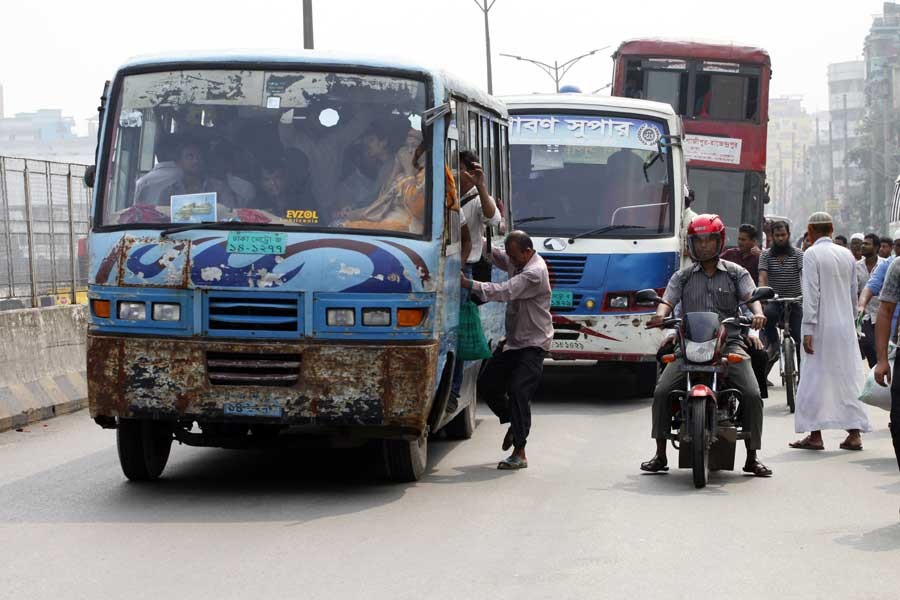
Published :
Updated :

Despite a number of efforts, public transport system in the country continues to be inefficient and chaotic. The inefficiency has made mobility of the people costlier, mostly in the urban areas. But it is the capital city where the cost is the highest as reflected in different indicators.
In Dhaka, public transport is almost entirely road-based. It also consists of both motorised vehicles like buses, minibuses, auto rickshaws, human haulers and non-motorised vehicle like cycle rickshaws. Thus a disorderly situation is prevailing for long and is also growing day by day.

One of the reasons for the disorder is the mindset that public transport is for low income people or at least for those who can't afford private cars or hired vehicles. Thus the poor quality of buses and minibuses are on the roads and highways. Any move to improve the quality of public transport and discipline the services is hardly visible.
The Seventh Five-Year Plan (7FYP) stressed on improving public transport system. It rightly said, "Buses are the only mode which can carry a large number of people at one time and has the potential to cater to all income groups. But the number of operational buses is not more than 20 to 25 per cent of the number required to meet the demand. Moreover bus service in the city is characterised by overcrowding, lengthy waiting, difficulty in transferring from one route to another, long distance to and from bus stop. So many routes, few buses with frequent unauthorised stoppages hamper free movement of traffic all around the big cities and highways."
Nevertheless, revamping Dhaka's public transport system appears to be too far away. Rather, inadequate number of buses is contributing to the sharp rise of private vehicles-- cars and motorbikes. Statistics available with Bangladesh Road Transport Authority (BRTA) showed that it took around 40 years for private cars to cross 0.15 million mark but around 0.10 million cars were added in the last seven years in Dhaka. In a similar vein, number of registered motorcycles jumped by 117 per cent during the period under review. Up to 2010, total number of registered motorcycles was 0.21 million but in the next seven years it stood at 0.51 million.
The surge in private vehicles in the current decade, starting from 2011, may be interpreted with a number of socio-economic factors. The rise in per capita income thanks to consistent economic growth enabled a growing number of urban people to own private vehicles.
No doubt the growth in personal ownership of cars and motorcycles give a section of the urban people better mobility. They are less reliant on public transport and have some freedom to avoid the chaotic and unpredictable traffic. As a result, use of effective public transport, buses and minibuses to be precise, has not been increasing adequately.
The Revised Strategic Transport Plan (RSTP) estimate showed that 47 per cent of Dhaka commuters used buses, nine per cent private cars and two per cent motorcycles in 2014. Use of non-motorised vehicle or cycle rickshaws is also high, around 37 per cent.
In fact, rise of private vehicles coupled with inept public transport makes the mobility of urban people costlier. Growing private cars are increasing the traffic congestion, while motorcyclists with their unruly conduct are making the traffic management difficult day by day.
Surge of private vehicles also increased energy consumption in the transport sector. Transport is the third largest energy consumer after industry and residences. Around 15 per cent of the country's total energy goes to the transport sector which is dominated by road transports. Again, 60 per cent of petroleum is consumed by the transport sector. The growing energy consumption of vehicles has caused environmental impact especially in the urban areas where frequency of motorised vehicles is high. Emission from these vehicles is on the rise due to inefficiency in fuel uses. A large number of unfit buses ply the roads and add to the emission. The capital city has already become one of the most polluted cities in the world where air quality is unhealthy and hazardous.
There are some social costs also. Use of motorcycles gradually makes people more individualistic. The unruly and insensitive attitude of most of the motorbike drivers in Dhaka is a clear reflection. This type of attitude is gradually disrupting social harmony. Private car is also contributing to the erosion of social values. It is not that the private vehicles turn their owners insensitive and selfish all on a sudden. Rather the compulsion to use the private vehicles with little desired benefits due to mismanagement in road traffic makes the case worse.
On the other hand, resentment among a large section of people who use inept public transport is rising slowly towards the users of private cars. Cycle rickshaw pullers along with CNG-run auto-rickshaw and battery-run easy bike drivers make no attempt to conceal their hatred for private cars. This is reflected in frequent squabbles on the road between car drivers and drivers of other vehicles. Thus a social disharmony is gradually spreading. It is difficult to quantify the cost of social disharmony in monetary terms. But the impact in the long-term is sure to cost more than just money.


 For all latest news, follow The Financial Express Google News channel.
For all latest news, follow The Financial Express Google News channel.